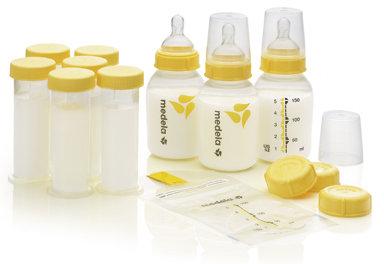Breastmilk Collection and Storage

How to Collect Breastmilk for Newborns
- Wash hands well with soap and water.
- Wash all the collecting bottles and breastpump parts that touch your breasts or the milk. Use hot, soapy water or a dishwasher. Rinse carefully. Air dry on a clean towel. When soap and water are not available use Medela Quick Clean products. If your baby is premature or ill, the hospital may ask you to sterilize your pump parts.
- Read the instruction book that comes with your pump and follow the suggestions. Sterilize your pump parts once a day as described.
- Practice pumping when you are rested, relaxed and your breasts feel full. Once a day try to nurse your baby only on one side and pump the other breast. Or pump for a few minutes if your baby skips a feeding or nurses for only a short while. Read the Storage Guidelines chart to learn how to store breast milk. Be sure to use the right size breastshield so that your nipple fits comfortably. Medela makes different sizes of PersonalFitT breastshields to fit all nipple sizes, from small to extra large.
Working Moms
- Working moms can help their baby learn to take a bottle once breastfeeding is going well. It is best to wait for 3 to 4 weeks to introduce bottles. If you are having problems breastfeeding, ask for help.
- Begin to pump to store milk 1 to 2 weeks before returning to work. Many employed moms use the fresh milk they pump at work for feedings the next day. They refrigerate Friday's milk for use on Monday. Save your frozen milk for emergencies.
- Pump 3x during an 8 hour work shift, or every 3 hours you are away from your baby. 10 minutes of pumping during breaks and 15 minutes of pumping during lunch with a good pump will help protect your milk supply. If you can't pump 3x, pump as much as you can during each day. Breastfeeding in the evening and over the weekend helps your milk supply and protects your special bond with your baby.
Storing Breastmilk
- It is normal for pumped milk to vary in color, consistency and scent depending on your diet. Stored milk separates into layers. Cream will rise to the top. Gently swirl the warmed bottle to mix the milk layers.
- You can continue to add small amounts of cooled breastmilk to the same refrigerated container throughout the day. Avoid adding warm milk to already cooled milk.
- Store your milk in glass or hard plastic containers, or in milk storage bags made especially for breast milk. The Medela Collection-Storage-Freezer (CSF) Bag is designed with two-layer construction to protect your stored milk. The bags come with twist ties for easy sealing. Place smaller bags inside a larger food storage bag to prevent accidental punctures.
- Freeze milk in 2 to 5 oz portions. Small amounts will thaw more quickly. You will waste less milk this way and will avoid over-feeding. Liquids expand when frozen. Be sure to leave some extra room at the top of the container so the bottle or bag won't burst.
- Seal containers tightly. Write the date on a piece of masking tape on the bag or bottle. Use the oldest milk first.
- If you do not plan to use the milk within a few days, freeze it right away in the coldest section of your freezer. Do not place the bottle or bag up against the wall of the freezer.
Breastmilk Storage Guidelines (For Healthy Term Babies)
| Freshly expressed breastmilk | Thawed breastmilk (previously frozen) | |
| Room Temperature | 4 hours at 66-72°F 19-22°C) | Do Not Store |
| Cooler with 3 Frozen Ice Packs | 24 hours at 59°F (15°C) | Do Not Store |
| Refrigerator | 5-7 days at 32-39°F (0°C) | 24 hours |
| Self Contained Refrig/Freezer Unit | 3-4 months | Never refreeze thawed milk |
| Deep Freezer | 6-12 months at 0°F (-19°C) | Never refreeze thawed milk |
Defrosting
- Thaw milk overnight in the refrigerator, or hold the bottle under warm running water to quickly thaw. You can also place the sealed container in a bowl of warm water for 20 minutes to bring it to body temperature.
- Thawed milk is safe in the refrigerator for 24 hours. Do not refreeze.
CAUTION: Never microwave breastmilk. Microwaving can cause severe burns to baby's mouth from hot spots that develop in the milk during microwaving. Microwaving can also change the composition of breastmilk.
Feeding Tips
- Choose a slow-flow bottle nipple and limit feeding size to 3 to 5 oz of milk for babies younger than 6 months.
- Remove the bottle nipple out of the baby's mouth periodically to let the baby catch his or her breath.
- Pause to burp the baby when needed.
- If baby seems fussy in between feedings it may be because of thirst. Offer 1 to 2 oz of milk. Babies 4 months or older can have a sip of water from a cup.
- Avoid over-feeding. Offer a pacifier or teething toy to give your baby more sucking enjoyment after finishing a bottle.
- Sometimes, babies do not fully finish bottles of breastmilk. Mothers wonder if they can re-refrigerate and re-use this milk. We have no information about whether or not this is safe to do. Please check with your doctor.
Your Milk Supply and Your Baby's Needs
- We used to think that mothers needed to make more and more milk as their babies grew. Scientists now know that a healthy milk supply remains fairly constant over the 6 months of exclusive breastfeeding.
- During the early weeks, babies eat very frequently and grow very quickly. By Day 10, babies should recover any lost birth weight. For the next few months, little girls should gain about an ounce a day, and little boys slightly more than an ounce.
- Around 3 to 4 months, a breastfed baby's rate of growth begins to slow down. Continuing to gain weight rapidly after this time may contribute to obesity later on. This means that the milk supply established in the early days will continue to satisfy the baby until it is time to introduce solids at 6 months.
- By the end of the first week of life, women who are breastfeeding one baby normally make between 19 to 30 oz of milk each day. Infants between 1 and 6 months of age normally drink an average of 19 to 30 oz a day. (Daley, Owens, Hartmann, 1993.) An average size "meal" for a baby is between 3 to 5 oz of breastmilk. Formula is harder to digest and less well absorbed. Formula fed babies may need larger feeds. Consult your doctor for advice.
Essential Breastfeeding Support and Baby Care ItemsTo see a more comprehensive list of the essential products that our Lactation Professionals have recommended, visit Essential Breastfeeding and Baby Care Products
See Other Breastfeeding and Baby Care Help Topics
References:
Butte N, Garza C, Smith E, Nichols B: Human milk intake and growth in exclusively breast-fed infants, J Pediatrics 1984; 104:187-194.
Daly S, Owens R, Hartmann P: The Short-Term Synthesis and Infant-Regulated Removal of Milk in Lactating Women, Experimental Physiol 1993; 78:209-220.
Dewey K, Heinig M, Nommsen L, Peerson J, Lonnerdal B: Growth of breast-fed and formula-fed infants from 0-18 months. The DARLING study, Pediatrics 1992; 89(6):1035-1040.
Dewey K: Is breastfeeding protective against child obesity? J Human Lactation 2003; 19(1):9-18.
Hamosh M, Ellis L, Pollock D, et al: Breastfeeding and the Working Mother: Effect of Time and Temperature of Short-term Storage on Proteolysis, Lipolysis, and Bacterial Growth in Milk, Pediatrics 1996; 97(4):492-498.
Lawrence R and Lawrence R: Breastfeeding: A Guide for the Medical Profession, 1999.
Quan R, Yang C, Rubinstein S, et al: Effects of Microwave Radiation on Anti-infective Factors in Human Milk, Pediatrics 1992; 88:667-679.
Sosa R, Barness L: Bacterial growth in refrigerated human milk, Am J Dis Child 1987; 141:111-115.
Stock J, Morhbacher N: The Breastfeeding Answer Book, La Leche League International, 2003.
Daly S, Owens R, Hartmann P: The Short-Term Synthesis and Infant-Regulated Removal of Milk in Lactating Women, Experimental Physiol 1993; 78:209-220.
Dewey K, Heinig M, Nommsen L, Peerson J, Lonnerdal B: Growth of breast-fed and formula-fed infants from 0-18 months. The DARLING study, Pediatrics 1992; 89(6):1035-1040.
Dewey K: Is breastfeeding protective against child obesity? J Human Lactation 2003; 19(1):9-18.
Hamosh M, Ellis L, Pollock D, et al: Breastfeeding and the Working Mother: Effect of Time and Temperature of Short-term Storage on Proteolysis, Lipolysis, and Bacterial Growth in Milk, Pediatrics 1996; 97(4):492-498.
Lawrence R and Lawrence R: Breastfeeding: A Guide for the Medical Profession, 1999.
Quan R, Yang C, Rubinstein S, et al: Effects of Microwave Radiation on Anti-infective Factors in Human Milk, Pediatrics 1992; 88:667-679.
Sosa R, Barness L: Bacterial growth in refrigerated human milk, Am J Dis Child 1987; 141:111-115.
Stock J, Morhbacher N: The Breastfeeding Answer Book, La Leche League International, 2003.




